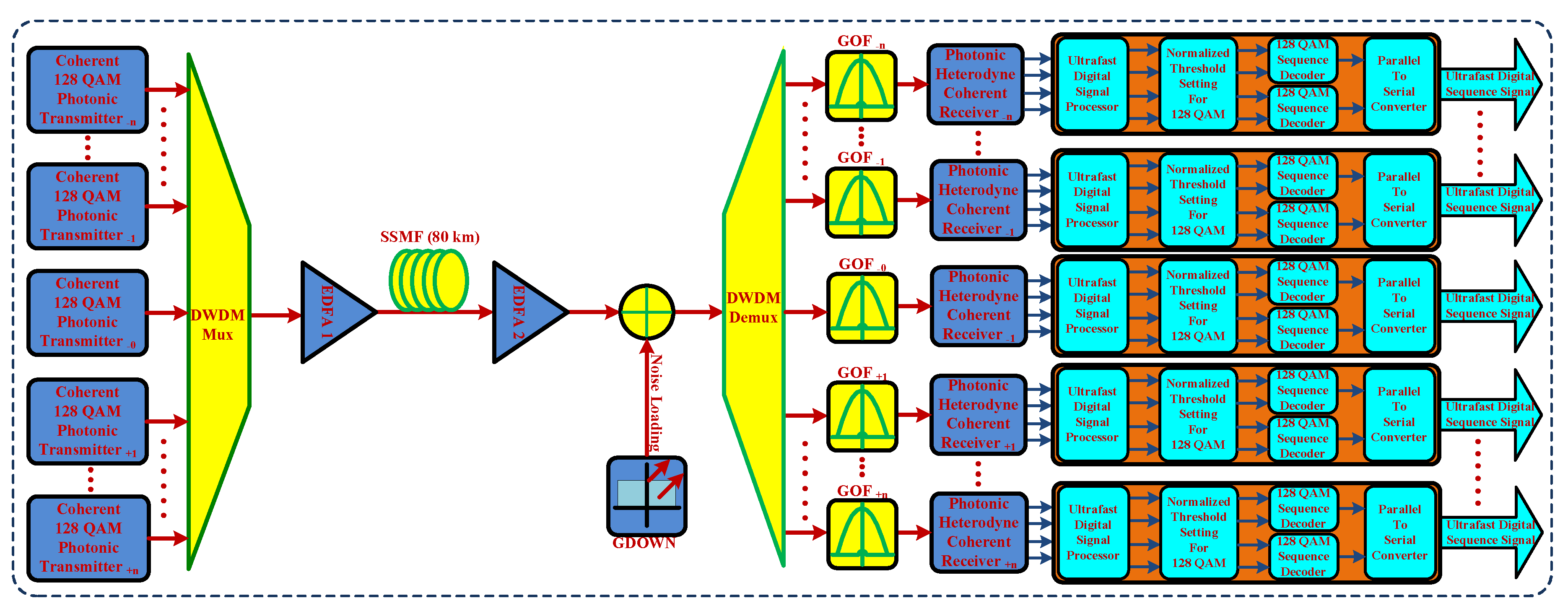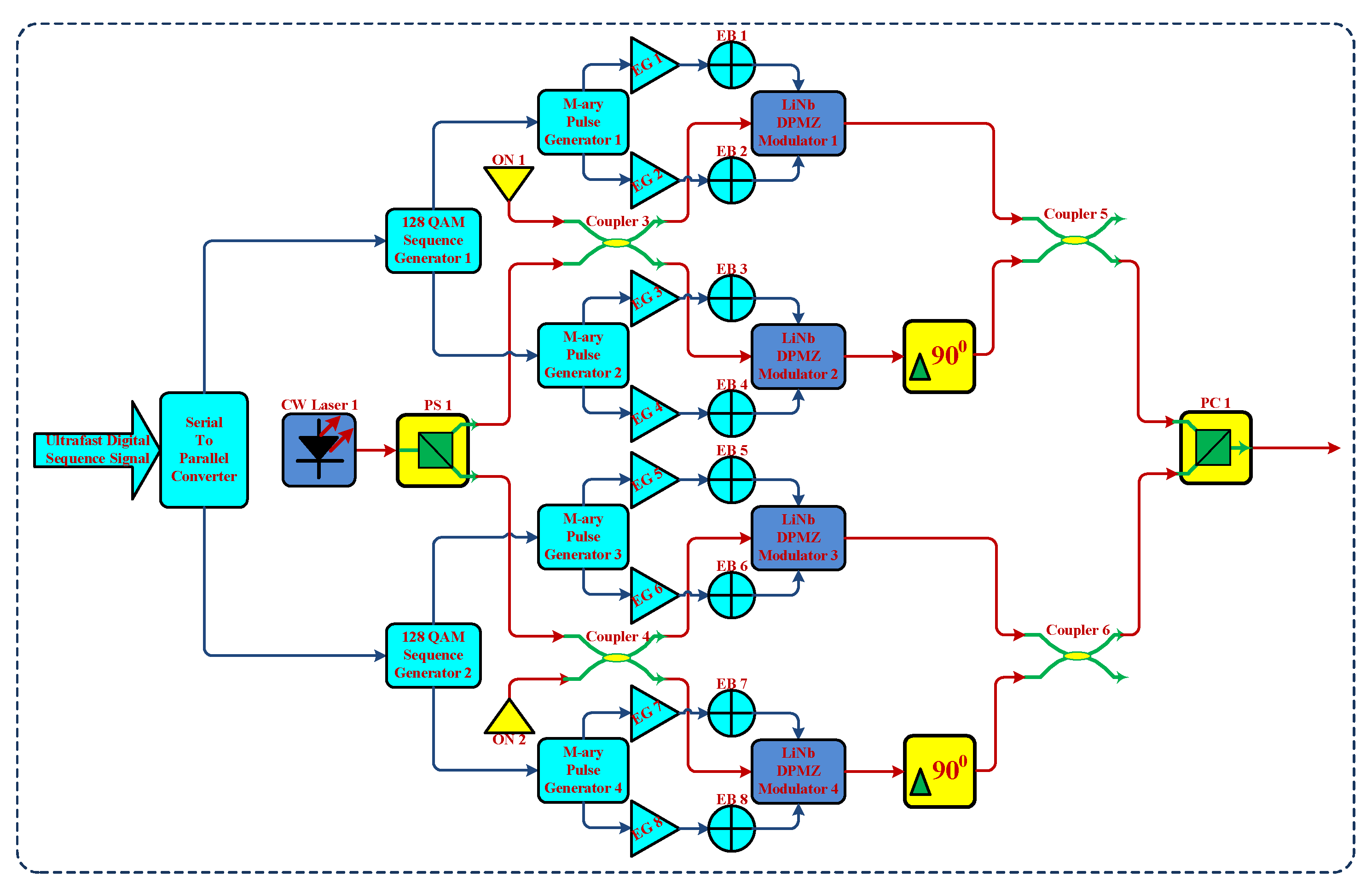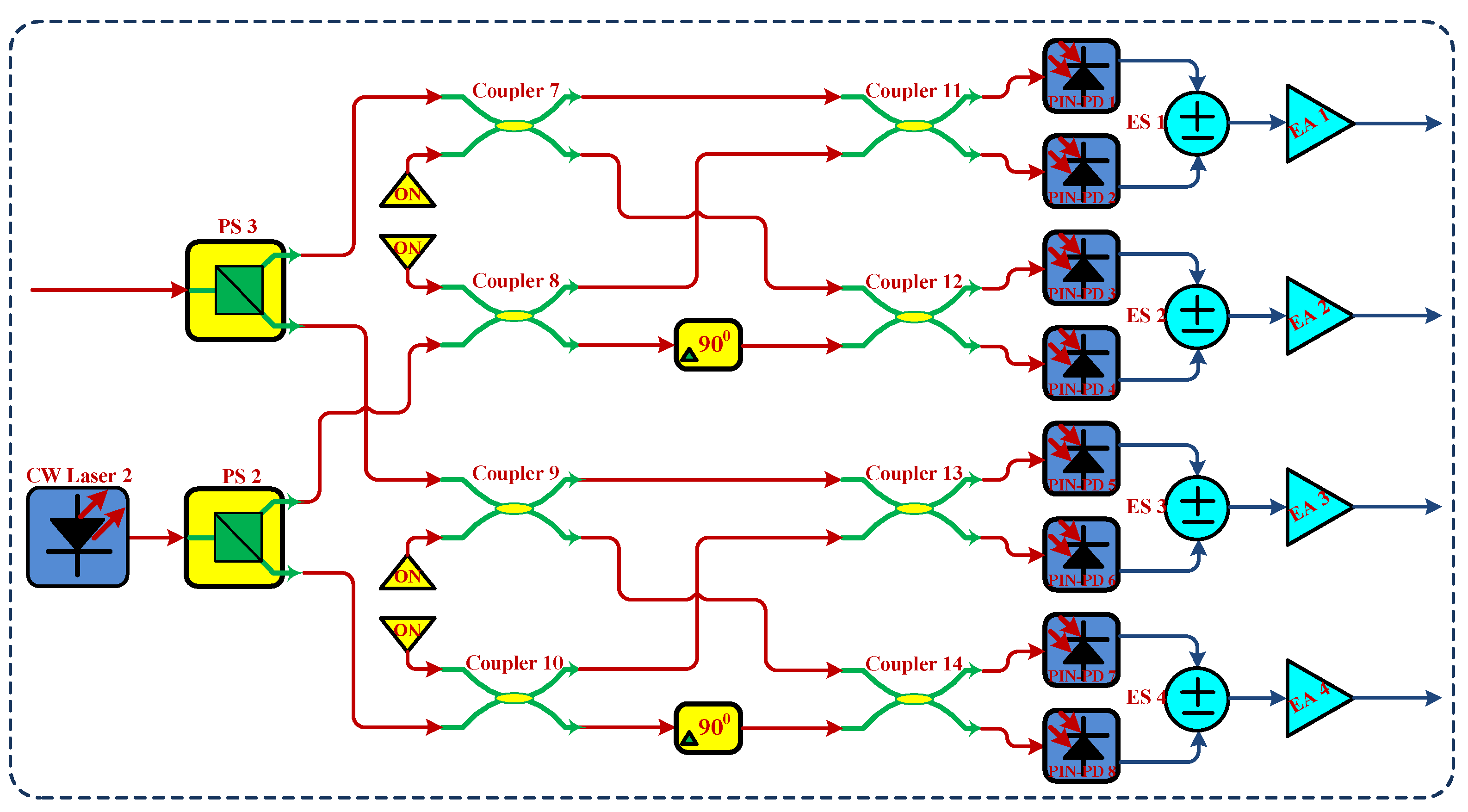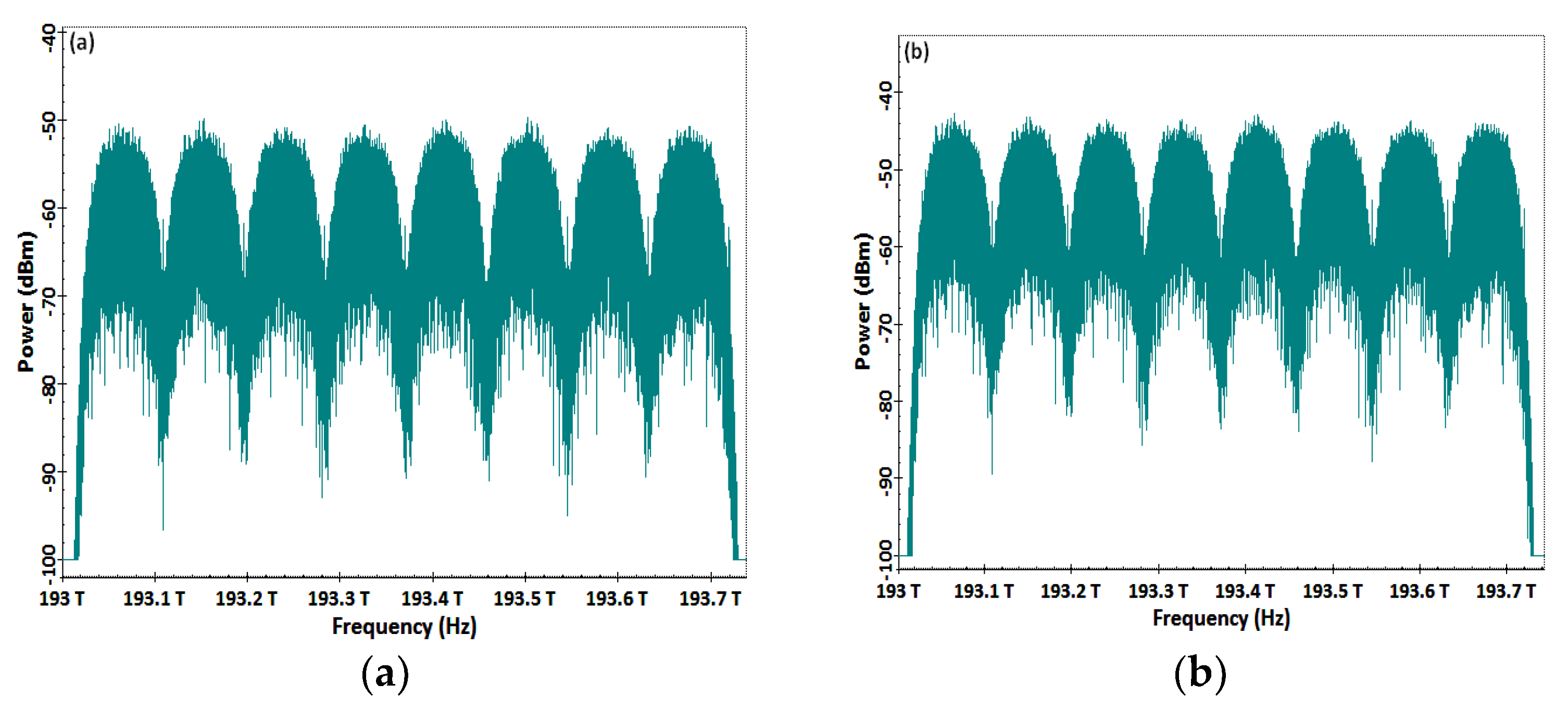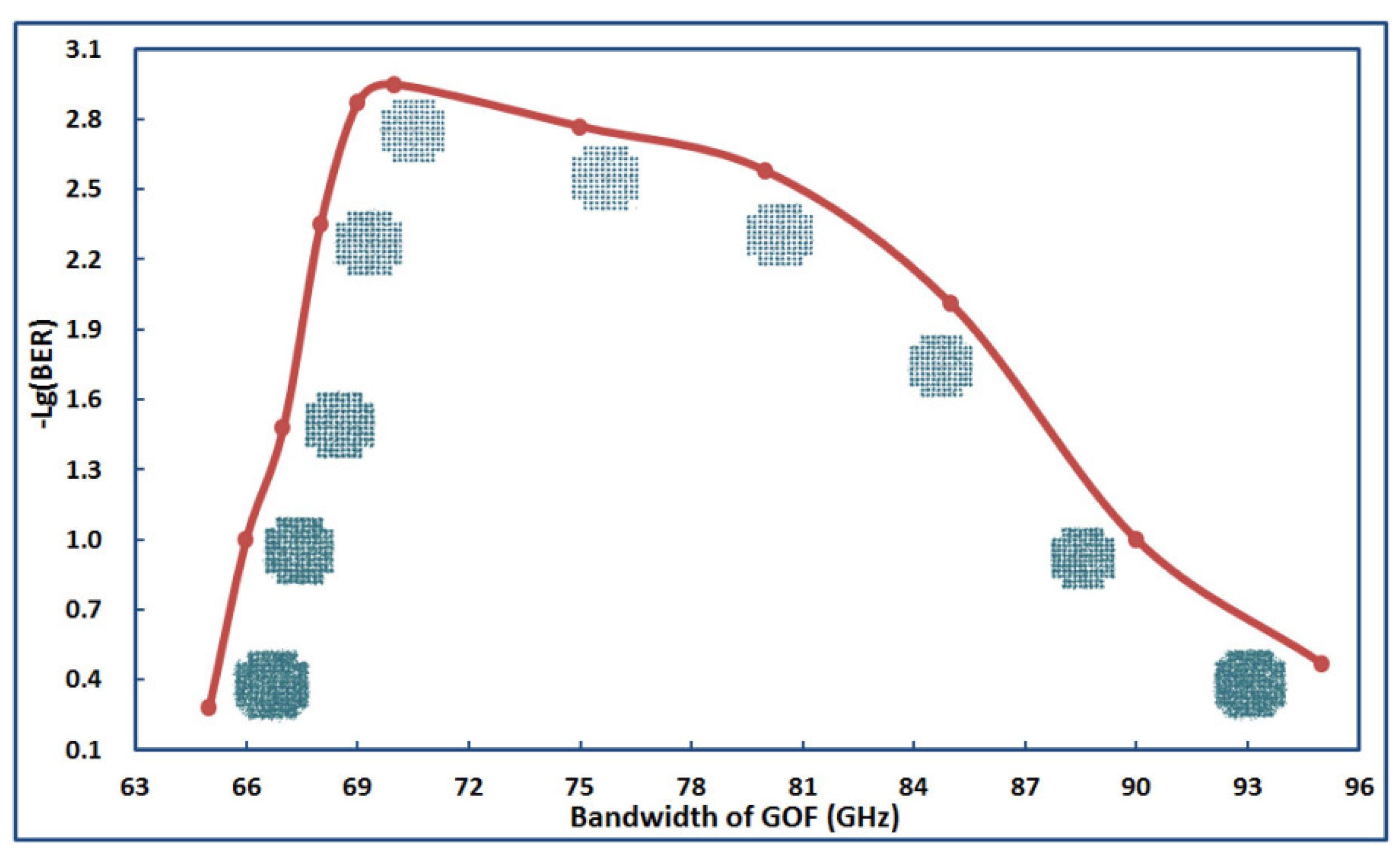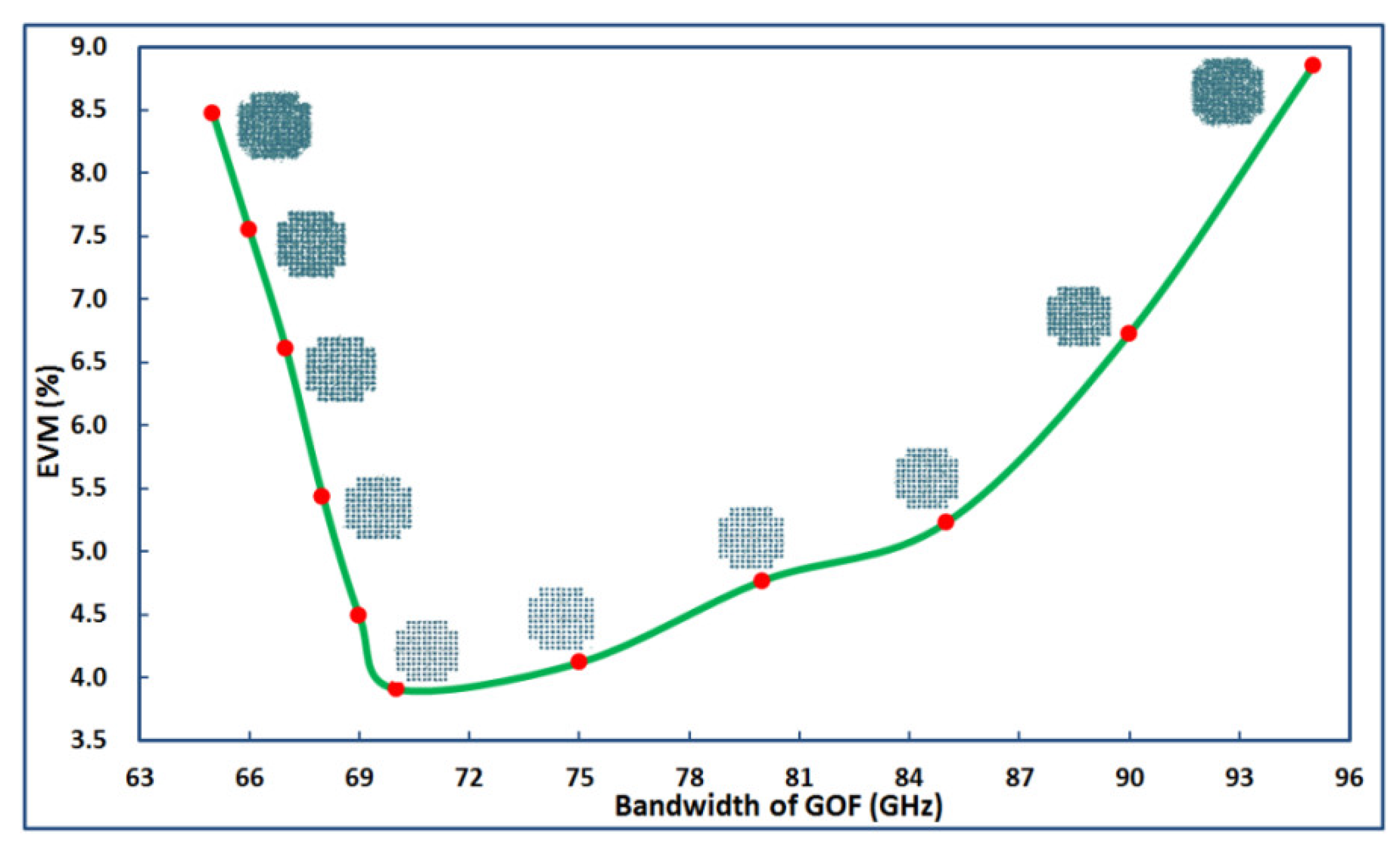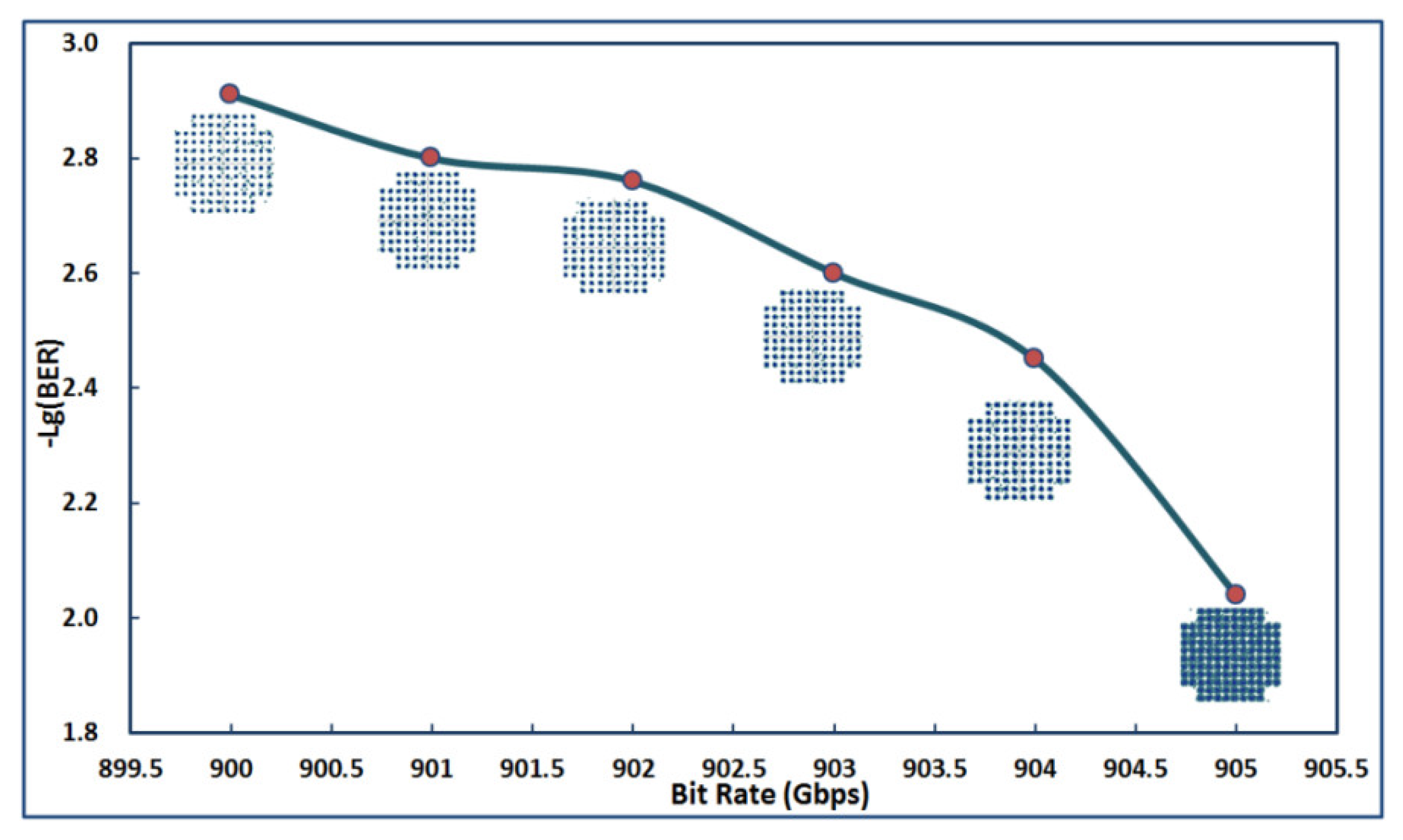1. Introduction
With the rapid development of the Internet of Things, mobile internet, and cloud computing, massive data of Petabyte (10
15 bytes) is generated every day. The mass data makes the capacity of the backbone transmission networks increase rapidly. The optical networks with ultra-large capacity shoulder the fundamental service-transmission function of the backbone transmission networks. The sustained multiplication of the bandwidth requires higher capacity for the backbone transmission networks. The transmission systems with large capacity and high bandwidth become the development direction of future optical networks. Consequently, upgrading the transmission capacities of the backbone networks with the technique of dense wavelength division multiplexing (DWDM) on a large scale is imperative. One of the key techniques is to enhance the transmission capacity of a single wavelength. Major network operators around the world have initiated experimental tests and engineering verification of single-carrier optical fiber communication system with a rate of 400 Gbps. Currently, the transmission rate of a single wavelength is evolving from 100 Gpbs to 400 Gbps. Analyzing the core mechanisms and solving the key problems of single-wavelength optical fiber communication system with 400+ Gbps has become a recent focus in academia and industry [
1,
2,
3,
4,
5,
6,
7]. In 2013, Bell laboratories reported a dual-carrier transmission system with the transmission distance of 320 km; the code-type of the transmission system was 64 quadrature amplitude modulation (QAM) format; and the capacity was up to 1.5 Tbps [
8]. In 2014, Bell laboratories reported a multi-carrier transmission system with the single-channel rate of 1 Tbps again; the code-type of the system was 16QAM; the transmission distance was 480 km; and the spectral efficiency of the system was 5 bps/Hz [
9]. Compared with optical communications with direct-detection, coherent optical communications [
10,
11,
12,
13,
14,
15] have the advantages of high receiving sensitivity and anti-polarization dispersion. In addition, the coherent detection can support M-ary modulation format and effectively utilize the bandwidth of the spectrum. Consequently, the technique of coherent optical communication is widely used in DWDM systems.
By analyzing the latest research in this field [
1,
2,
3,
6,
8,
9], we find that: (1) when the channel spacing is less than 50 GHz in a DWDM system, the cost of the array waveguide grating (AWG) and the difficulty of the production engineering will be greatly increased, and the interference between adjacent channels will be very serious; (2) the ratio of the transmission speed of a single wavelength to the spacing between two adjacent channels is relatively small, that is to say, the utilization efficiency of the spectrum is low; and (3) the coherent modulation and coherent detection are the core techniques in DWDM systems. For these reasons, we combine high-order coherent modulation with Gaussian optical filtering in an optical transmission system, and a DWDM system with ultra-high-speed and large capacity is realized. In this DWDM system, the two adjacent wavelengths spacing is 0.7 nm, the transmission rate of the single-wavelength is 904 Gbps, and the spectral efficiency is 10.33 bps/Hz. We also analyze the transmission performances of the DWDM system from the angles of the optical signal-to-noise ratio (OSNR) and the bandwidth of Gaussian optical filter (GOF).
2. Pulse Shaping
The processing procedure of a modulated photonic carrier with the modulation format of 128QAM which is gotten by using Gaussian optical filtering on an optical shaping is given in
Figure 1.
The ultra-high-speed photonic carrier transmission with the modulation format of 128QAM is achieved by using optical phase dual-arm modulation with four differential signals, which are converted by series-to-parallel. In order to make it easy to understand, one of the photonic carriers with 128QAM based on optical phase dual-arm modulation is theoretically analyzed. The angular frequency of the continuous laser-carrier in the 128QAM photonic transmitter is
, and then, the continuous laser-carrier can be described by:
where
is the amplitude of the optical field output from the carrier-laser.
is modulated by
and
, which are output from 128QAM sequence generator via the dual port Mach-Zehnder modulator (DPMZM) in the coherent 128QAM photonic transmitter. The expression of the modulated signal output from the DPMZM can be further described by [
16,
17]:
where
is the output of the laser-wave;
is the insertion loss;
and
are the input electrical voltages for the upper modulator arm and the lower modulator arm, respectively;
and
are the configurations for the bias voltage 1 and bias voltage 2 of the DPMZM;
is the switching modulation voltage;
is the switching bias voltage;
γ is the optical power splitting ratio of the both Y-branch waveguides; and there is a definite functional relationship between
and the extinction ratio [
17]. The extinction ratio (ER) of the DPMZM is 20 dB; the parameters of
and
are configured as 3 V; the setting of
is 5 dB; and the settings of
and
are 0 V.
From [
16,
17], and Equation (2)
, we can derive the following:
where
and
are the special constants, which can be described by:
where
and
Vs2(
t) are two-channel electrical signals output from 128QAM sequence generator; the numerical values of them are 0 or 1 at every moment, which can be regarded as constants.
From Equation (3), by the method of the Bessel function expansion, we can see that a modulated photonic-carrier signal contains many photonic harmonic-waves, and the angular frequencies of the harmonic-waves are (n = 0, ±1, ±2, ±3, ±4, ±5, and more). In other words, the angular frequency space of the adjacent harmonic-wave is . We can also see that the power of the central photonic harmonic-wave is maximum, and the powers of the others photonic harmonic-waves decrease gradually with the increase of n, and each photonic harmonic-wave contains the same ultra-high-speed modulation information.
Lastly, we can obtain the central photonic harmonic-wave from the output of the coherent 128QAM photonic transmitter via an appropriate optical filtering, where the suitable filter is a Gaussian optical filter. The functional model of the optical filter can be described by:
where
is insertion loss,
is center frequency,
is bandwidth, and
is filtering order.
From
Figure 1, it can be seen that only the bandwidth of the central carrier-wave is kept. The more modulated photonic carrier-waves can be transmitted over the limited bandwidth of a certain specific wavelengths; the more available wavelength channels can be realized in a DWDM transmission system.
3. System Architecture and Transceiver Units
The ultra-high-speed DWDM transmission system with a large capacity based on 128QAM and Gaussian optical filtering is shown in
Figure 2.
The multi-carrier signals with the adjacent wavelength space of 0.7 nm produced by multiple coherent photonic transmitters with the same modulation format of 128QAM are multiplexed into an SSMF via the DWDM-Mux; the multiplexed multiple carriers are amplified by EDFA 1; the amplified optical signals are transmitted over 80 km with the SSMF, amplified again via EDFA 2, de-multiplexed via DWDM-Demux, mixed with the Gaussian distributed optical white noise (GDOWN), and filtered by GOFs successively; The filtered photonic signals are then successively processed via the photonic heterodyne coherent receivers, ultra-fast digital signal processors (UDSP), normalized threshold setting for 128QAM (NTS-128QAM), 128QAM sequence decoders (128QAM-SD), and parallel-to-serial converters (PTSC). Finally, the useful information is demodulated and the ultra-fast digital sequence signals are obtained. The main parameters of the critical components and key modules are shown in
Table 1.
The functional block diagram of the coherent photonic transmitter is shown in
Figure 3. The ultra-fast digital sequence signal is divided into two signals by the serial-to-parallel converter (STPC); the two signals are identically processed, and the up one is used to illustrate the modulation process of the ultra-fast signal. It is divided into two signals again via the 128QAM sequence generator 1, and these two signals are processed by M-ary pulse generator 1 and M-ary pulse generator 2, thus obtaining the two M-ary pulse signals. The two M-ary pulse signals are processed identically, we use the up one to illustrate the process. The two signals output from the M-ary pulse generator 1 are processed as bias via the EB 1 and EB 2. The two biased signals modulate a light-wave produced by a CW laser via LiNb-DPMZ modulator 1. The generating methods of the light-waves in LiNb-DPMZ modulator 1, LiNb-DPMZ modulator 2, LiNb-DPMZ modulator 3, and LiNb-DPMZ modulator 4 are same. We use the light-wave which is input into the LiNb-DPMZ modulator 1, for example, to illustrate the modulating process. The light-wave produced by the CW Laser 1 with the center frequency of (1550 ± 0.7 × N) nm and the line-width of 100 Hz is divided into two light-waves via PS 1, and the two divided light-waves are processed with the same way. These two light-waves are generated by the light-wave output from PS 1 via optical coupler 3, which are input into the LiNb-DPMZ modulator 1 and LiNb-DPMZ modulator 2 as modulated laser light-waves, respectively. The modulated photonic carrier-wave signal output from the LiNb-DPZM modulator 2 is processed via an optical phase shifter at 90°, and the photonic carrier-wave is coupled with the output of the LiNb-DPMZ modulator 1 via optical coupler 5. The modulated photonic carrier-wave output from the LiNb-DPMZ modulator 4 is processed via an optical phase shifter at 90°, and the photonic carrier-wave is coupled with the output of LiNb-DPMZ modulator 3 via optical coupler 6. The output of coupler 5 is combined with the output of coupler 6 via PC 1. The output of the coherent photonic transmitter with the modulation format of 128QAM are then obtained. It is noted that the parameters of the LiNb-DPMZ modulator used above are configured as, extinction ratio: 20 dB, switching RF voltage: 3 V, switching bias voltage: 3 V, insertion loss: 5 dB, modulation voltage 1:2 V, bias voltage 1:0 V, bias voltage 2:0 V, and modulation voltage 2:2 V.
The function block diagram of the photonic heterodyne coherent receiver is shown in
Figure 4. The photonic signals transmitted from the coherent photonic transmitter are split into two paths by PS 3 in the photonic heterodyne coherent receiver. The two photonic signals are processed with the same way. One of the two photonic signals is split into two new photonic signals via coupler 7; the new two photonic signals are processed with the same method. One of the new two photonic signals is input into coupler 11; and the other one is input into coupler 12. The continuous laser-wave emitted from CW Laser 2 with the center frequency of (1550 ± 0.7 × N) nm and the line-width of 100 Hz is split into two paths via PS 2, and these two photonic signals are processed with the same method. One of the two photonic signals is split into two new photonic signals, again via coupler 8. One of the two new photonic signals is processed via the optical phase shifter at 90°, and one is input into coupler 12, while the other is input into the coupler 11.
The two photonic signals output from coupler 11 are detected by two positive intrinsic negative photodiodes (PIN-PD 1 and the PIN-PD 2); two detected signals are processed by ES 1, and then amplified via EA 1. It is noted that the processing procedures and processing methods of coupler 11, coupler 12, coupler 13, and coupler 14 are same.
Figure 5 shows the flow diagram of the algorithm design for the UDSP which is used for the compensation of transmission impairments and signal reconstruction. The noise is removed by a Bessel filter with 3rd order. The sampled signal is re-sampled at a rate of
. A cubic interpolation is utilized to adapt the waveform of the sampled signal to the resampling rate. The first and
sampled signals are used for re-sampling, where
is the number of the samples per symbol. After the stage of adaptive equalizer, the signal stream is re-sampled further to
. The
sampled signal is used.
The imbalances of amplitude and phase within the quadrature (Q) signals and in-phase (I) signals are alleviated by using the compensation of QI. The Gram-Schmidt orthogonalization procedure (GSOP) [
18] is used for correcting non-orthogonalization. Two non-orthogonal components from the received signal by
and
can be defined, the results of the GSOP for a new orthonormal signals can be described by
and
, as follows:
where
is the correlation coefficient;
;
and
is the ensemble average operator.
Digital filtering can be used for compensating the chromatic dispersion (CD) that is resulting from propagation over fiber. The filter of dispersion compensating can be used in either frequency domain or time domain [
19]. The mathematical model of the transfer function for dispersion in the frequency domain can be characterized as follows:
where
is the propagation distance,
is the wavelength,
is the angular-frequency,
is the speed of light,
is the imaginary-unit, and
is the dispersion-coefficient of the optical fiber for the wavelength of
,
is the dispersion-slope, and
is the reference wavelength. A finite impulse response filter (FIR) of the time domain with
taps is utilized. The tap weights are described by:
where
,
is the Nyquist-frequency.
Nonlinear compensation with a digital back propagation (BP) method [
20] is performed. Back propagation needs the inverse nonlinear Schrödinger equation (NLSE) [
20] to be solved for the optical fiber link. For a single polarization and without spatial domain, the NLSE can be described by:
where
is the nonlinear-operator,
is the differential operator accounting, and
is the complex field, which are given by:
where α is the attenuation coefficient,
is the group velocity dispersion factor, and
is the nonlinearity factor.
Timing recovery is used for the synchronization of the symbols. The sampling phase and sampling frequency must be determined. The digital square and filter algorithm is utilized [
21]. The adaptive equalizer (AE) is used for the compensation of polarization mode dispersion (PMD), the compensation of residual chromatic dispersion and reducing inter-symbol interference. Two-stage Constant modulus algorithm-radius directed (CMA-RD) algorithm is used [
22,
23]. The received signals are described by:
where
are symbols,
is the symbol period,
is the carrier frequency offset,
is the carrier phase, and
are zero-mean Gaussian-random-variables. We can then deduce the frequency offset estimate (FOE) which is based on the maximization of the period-gram of
as shown below [
24]:
The blind phase search (BPS) algorithm [
25] is utilized to recover and subsequently to remove the remaining phase mismatch between the signal and the local oscillator. We adopted the BPS algorithm for the carrier phase estimation (CPE).
4. Simulations and Performance Analysis
The transmission system is simulated by OPTISYSTEM and MATLAB. The transmission rate is configured as 900 Gbps; the transmitted sequence-length is configured as 262,144 bit; the number of samples per bit is configured as 4; the Guard-bits is configured as 10; the OSNR is configured above 30 dB; the transmitted optical signal power is configured as 0 dBm.
The interference problems of the adjacent channels can be tested through eight channels in the DWDM system. The interfered degree of adjacent channels in the DWDM system with eight channels is almost the same as that in the DWDM system with more than eight channels. This is because the interference problems of the channels are caused by the bandwidth of the adjacent channels. In our proposed system, the wavelength spacing of adjacent channels is 0.7 nm; the wavelength spacing of non-adjacent channels is more than two times of 0.7 nm, that is to say, the wavelength spacing of non-adjacent channels is more than 1.4 nm. There will be almost no correlation between one channel and the other channels when the signal of each channel is filtered via the GOF, that is, the non-adjacent channels don’t interfere with each other. From the configuration of parameters, we see that the optical spectral utilization efficiency of the transmission channels is up to 10.29 bps/Hz, and it can be calculated by:
The DWDM transmission system with eight channels is simulated and analyzed. The spectrogram output from DWDM-Mux, the spectrogram output from EDFA 1, the spectrogram output from GOF
-0 and the constellation diagram output from UDSP are shown in
Figure 6a–d, respectively. In
Figure 2, the ultra-high-speed photonic-carriers with the adjacent channel spacing of 0.7 nm are multiplexed via DWDM-Mux; the multiplexed signals are amplified via EDFA 1; the amplified signals are transmitted via SSMF; and the signals are amplified by EDFA 2, de-multiplexed by DWDM-Demux, and filtered by GOF
-0 successively.
The spectrograms output from the other GOFs are similar to
Figure 6c, and the locations of the center frequencies are different. The constellation diagram of the coherent receiver unit is shown in
Figure 6d. From
Figure 6d, it can be seen that the constellations are arranged orderly and clearly.
The order of the GOF is 3; the bandwidth of the GOF is 70 GHz; and the insertion loss of the GOF is 1 mw. The mathematical model of the GOF can then be further described by:
when the bit rate of the transmission system is configured as 900 Gbps, the constellation diagrams and the diagram of the curve between the bandwidth of the GOF and bit error rate (BER) are shown in
Figure 7. The constellation diagrams and the diagram of curve between the bandwidth of the GOF and error vector magnitude (EVM) are shown in
Figure 8.
From
Figure 7, it can be obtained that the BER of the transmission is greatly influenced by the bandwidth of the GOF. The BER of transmission channel will be worse when the bandwidth of the GOF that is on a wavelength-link diverges from 70 GHz. The BER of transmission channel will be seriously deteriorated when the bandwidth of the GOF that is on a wavelength-link is less than 67 GHz. The constellations output from the UDSP will be arranged orderly and clearly when the bandwidth of the GOF is configured as 70 GHz. However, the constellations output from the UDSP will become blurred when the bandwidth of the GOF diverges from 70 GHz.
From
Figure 8, it can be obtained that the EVM output from NTS-128QAM is seriously influenced by the bandwidth of the GOF. The EVM of the transmission channel will be worse when the bandwidth of the GOF that is on a wavelength-link diverges from 70 GHz. The EVM of transmission channel will be deteriorated seriously when the bandwidth of the GOF that is on a wavelength-link is less than 67 GHz. The constellations output from UDSP will be arranged orderly and clearly when the bandwidth of the GOF is configured as 70 GHz. However, the constellations output from the UDSP will become blurred when the bandwidth of the GOF diverges from 70 GHz.
According to
Figure 7 and
Figure 8, we can learn that BER and EVM are similarly influenced by the bandwidth of the GOF; the degree of influence shows a trend of near synchronization with the change of the bandwidth of the GOF. This also further verifies that there is a certain mathematical function relationship between EVM and BER.
Consequently, the bandwidth of the GOF plays a key role in the overall performances of the transmission system, so it is very important to configure the bandwidth of the GOF properly.
When the transmitted digital symbols of the coherent photonic transmitter are far greater than the number of the constellations (that is, the transmitted digital symbols are far greater than 128), the signal-noise-ratio (SNR) of the transmission system can be expressed as [
26]:
where
is the energy-spectrum of the noise signal and
is the energy per symbol of the useful signal. Then, the relationship between EVM and SNR can be further expressed as:
According to the relationship of the mathematical function between SNR and BER, the following mathematical model can be obtained from [
26]:
where
is the energy per bit of the useful signal and
is the number of binary digits. For example, the sequence-number of 128QAM is 128 (that is,
M = 128), and
is the error function.
According to
and Equations (16) and (17) can be further described by:
Substituting
, and consequently, Equation (18) can be further expressed as:
Equation (19) can be described by:
where
;
, and it is a mathematical function with respect to EVM, where EVM is a variable.
From Equation (20), it can be obtained that there is a mathematical function relationship between BER and EVM in the system, which further demonstrates that the simulation results are reliable from the trend of curve changes in
Figure 7 and
Figure 8. The transmission speed of the communication system is configured as 900 Gbps and, the bandwidth of the GOF is set as 70 GHz. We can then obtain the relationship diagrams between BER and OSNR, and EVM and OSNR, which are shown in
Figure 9 and
Figure 10, respectively.
From
Figure 9, it can be obtained that OSNR has a large impact on BER, and BER decreases rapidly with the increase of OSNR, where BER will reach the optimum value when the value of OSNR is greater than 26 dB. From
Figure 10, it can be obtained that the value of EVM shows a large downward trend with the increase of OSNR, where EVM will reach the optimum value when the value of OSNR is greater than 24 dB.
According to
Figure 9 and
Figure 10, it can be seen that BER and EVM are similarly influenced by OSNR; the degree of influence shows a trend of near synchronization with the change of OSNR. This also further verifies that there is a certain mathematical function relationship between EVM and BER, and also further explains the correctness of Equation (20). Consequently, we can improve OSNR to ameliorate the transmission performance of the communication system.
Furthermore, when the parameters of transmission rates in the single channel are configured as 900 Gbps, 901 Gbps, 902 Gbps, 903 Gbps, 904 Gbps, and 905 Gbps, we can then obtain the constellation-diagrams and diagram of curves between the bit rates and BER, and the bit rates and EVM, which are shown in
Figure 11 and
Figure 12, respectively.
BER is a very important index to measure the performance of a transmission system. According to the conventions of the communication industry, the BER can be acceptable when it falls below the forward error correction threshold of 3.8 × 10
−3 (that is too say, −lg (BER) ≥ 2.42) for a high-speed digital coherent optical communication system. From
Figure 11, it can be seen that when the transmission rate of a single wavelength for the DWDM system configures 904 Gbps, the BER is about 3.8 × 10
−3; that is too say, when it is configured as N × 904 Gbps for the DWDM system, the transmission performance can be acceptable; meanwhile, the constellation-diagrams are very clear, that is too say, at the receiving terminal, the signals recover well and the distortion is not obvious. Consequently, from N × 900 Gbps to N × 904 Gbps, the transmission rate configuration for the DWDM system is reasonable, and it is also a good choice.
EVM is an index to measure the quality of modulated signal. It indicates the proximity between I/Q components and the ideal components when the receiver demodulates the signals; and the quality of EVM is related to the quality of the signal. In a high-speed digital optical communication, the EVM can be acceptable when it falls below 5%; and this indicator is commonly used in high speed coherent optical communication systems. From
Figure 12, it can be obtained that when the bit rate of a single wavelength for the DWDM system is 904 Gbps, the EVM is about 5%; that is too say, when it is configured as N × 904 Gbps for the DWDM system, the transmission performance can be acceptable; Moreover, the constellation-diagrams are very clear, that is too say, at the receiving terminal, the signals recover well and the distortion is not obvious. Consequently, from N × 900 Gbps to N × 904 Gbps, the transmission rate configuration for the DWDM system is reasonable, and it is also a good choice.
From
Figure 11 and
Figure 12, it can be seen that BER has a specific relationship with EVM in terms of the acceptability of transmission performance corresponding to the rate configuration. This further verifies the rationality of equation (20).
From the configurations and results of the simulations, we calculate that the optical spectral utilization efficiency of the transmission channels is up to 10.33 bps/Hz (904 Gbps/87.5 GHz ≈ 10.33 bps/Hz).
According to all simulations and demonstrations, we determine that the performances of the transmission system are acceptable when the bit rates of the transmission are configured from 900 Gbps to 904 Gbps.

